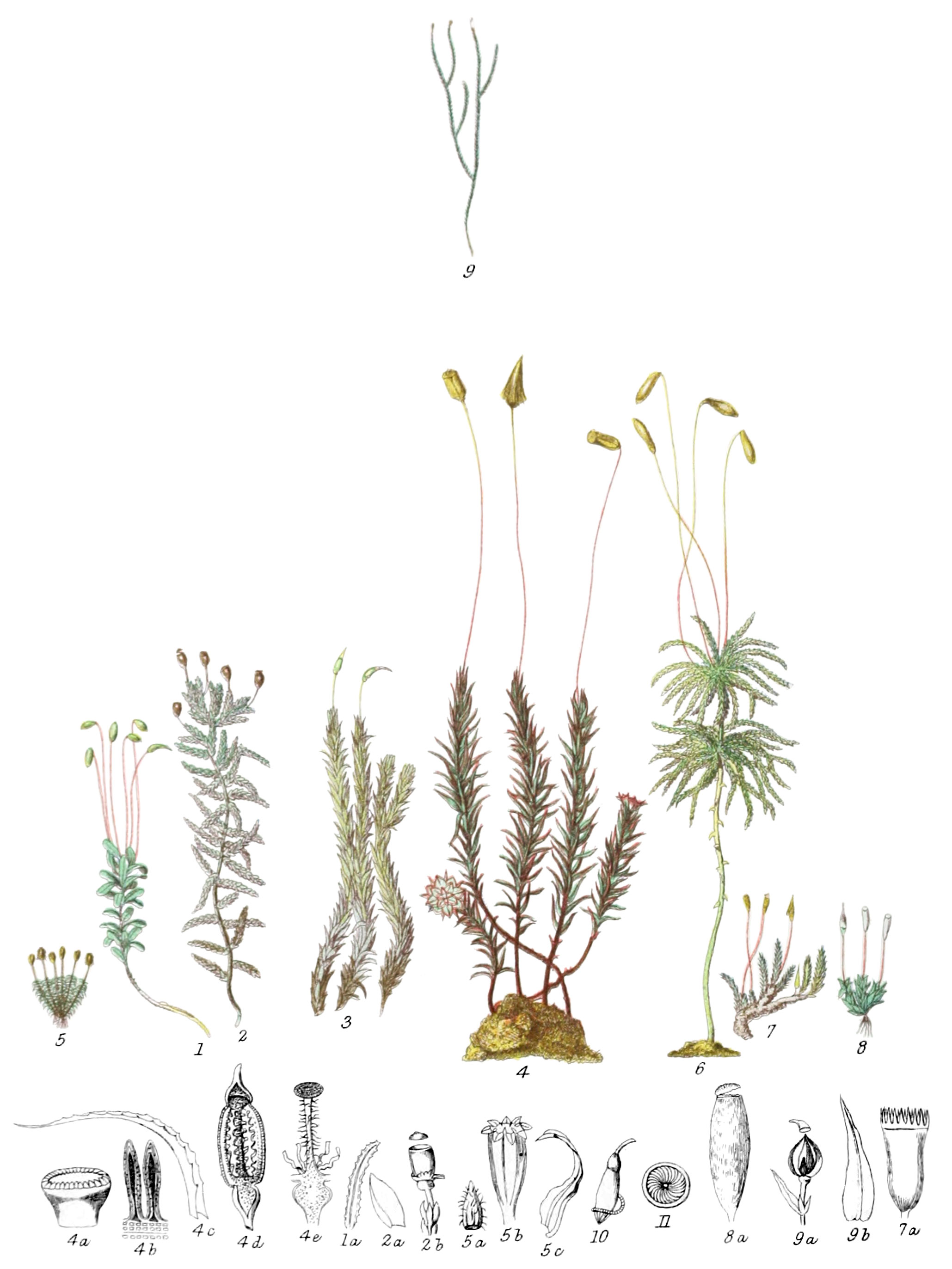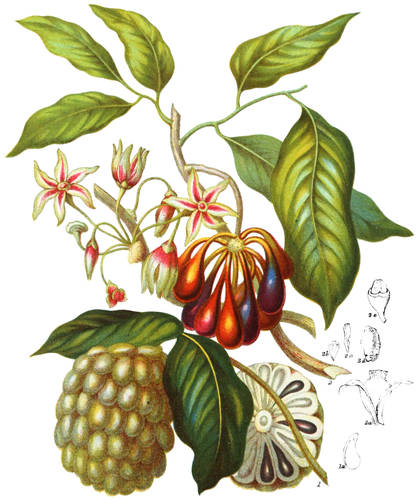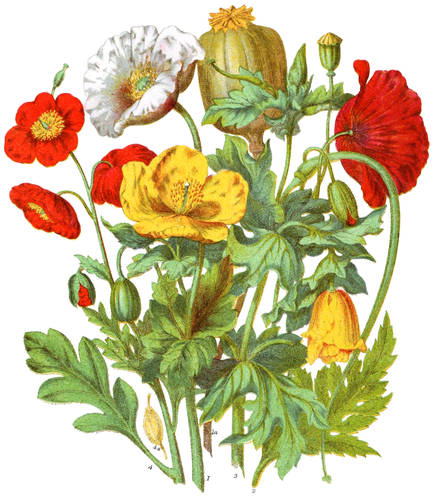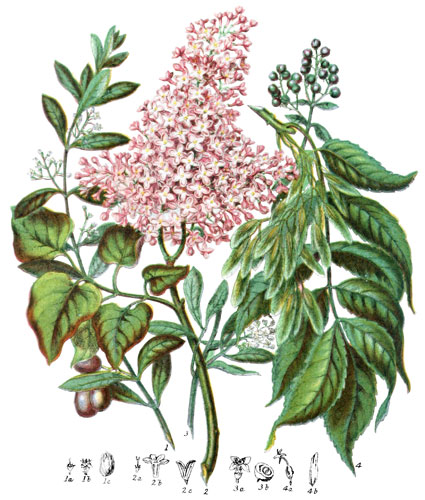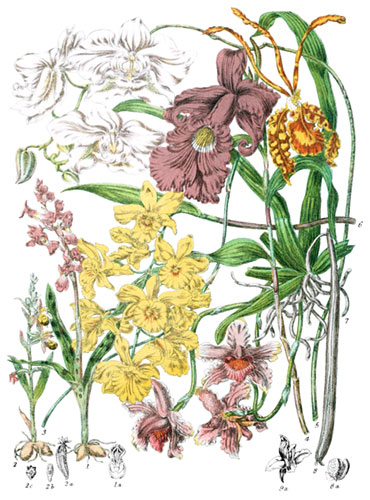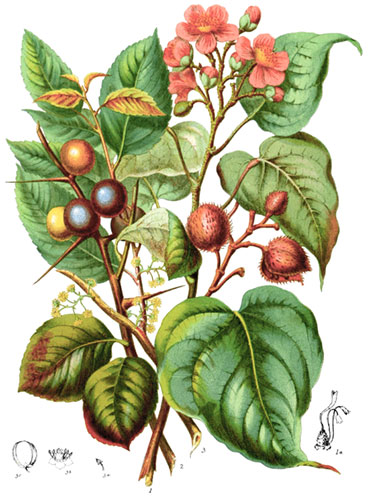Key characteristics
This Order contains small herbaceous plants, of cellular tissue only, terrestrial or aquatic, having fibrous roots, creeping or rect, covered with minute imbricated leaves, entire or serrated at the edges. The reproductive organs are of two kins, cylindrical bodies at the base of leaves containing small round particles and coiled up threads which move in water, and capsules or spore-cases on a stalk covered by a membranous calyptra, closed by an operculum or lid, beneath which are one or two rows of stiff cellular teeth called the peristome. A series of elastic cells is called the ring (10). In the centre of the spore-case is the column surrounded by spores. The spores germinate on the surface of the ground or in the trunk of trees, they produce first filaments thickly interlaced, like those of Conferva, from the joints of which leaf-buds spring.
These plants have close affinity with the Liverwort tribe by Jungermannia, but are distinguished by having an operculum to the spore case.
Slightly astringent properties exist in Polytrichum and others.
Mosses are amongst the lowliest classes of vegetation, and afford very little direct use to man or animals; yet they perform an important part of the great plan of creation, and though of minute size assist in countless numbers in the first work of covering barren rocks or volcanic soil with verdure, thus preparing the land for more valuable herbage. A great similarity prevails throughout the tribe, but endless variety is found in different species, both in the arrangement of the parts and in the manner of growth. Some form dense tufts not rising to the height of an inch, others grow more separately and imitate the aspect of more highly developed plants. The spore-case or urn is not always symmetrical on its stalk, in some species it is larger on one side than the other; the length of the stalk varies extremely, in some instances scarcely elevating the spore-case above he leaves, in others attaining several inches in height; it proceeds either from the ends of the branch, or from the side.
Select plants in this order
Not all plants listed are illustrated and not all plants illustrated are listed.
- Bryum (1), an ancient Greek name for moss, has been selected to give its name to this Tribe, being one of the most perfect in its various parts. The peristome of the spore-case is double, the outer terminating in sixteen teeth with a double row of cells, the inner or plaited membrane with single-celled teeth. The calyptra, or veil, is a smooth hood. The leaves are arranged in several rows and have a membranous notched edge. This genus grows very abundantly in various localities; in primæval forests and on plains in the Tropics, on arid Polar steppes, in low marshes and on lofty mountains, on sandy ground and on old walls, in Temperate climates.
- Sphagnum (2) is an example of a moss the spore-case of which has no peristome; the small mitre-shaped veil soon falls off, the flat operculum is detached when the spores are ripe. Several of the species are to be found in peat-bogs and form a large portion of the composition of the peat; their spongy nature absorbs much moisture, both from the air and soil. On the borders of marshes on the Sikkim Himalaya at 6000 feet, as well on level plains in Europe, Sphagnum will be observe. In Lapland it is food for reindeer, and it has been said that in the Arctic regions a kind of bread is prepared from it.
- On dry, sandy heaths and moors, in shady ravines, on mountains near the limits of perpetual snow, Dicranum (3) grows in thick masses, particular species in such situations as are adapted to them. the persitome has a single row of double-celled teeth.
- D. fulvum belongs to Nova Scotia, D. flexuosum to the Cape, D. vaginatum to the Andes, in valleys between 3000 and 4000 feet.
- D. fragile, nearly resembling our D. scoparium, is found in Nepal.
- Polytrichum (4), the largest and finest of British mosses, is very common on heaths, hedge-banks, and elsewhere. The stems producing only tufts of small leaves, in which are simple cylindrical cases of spores, are light and elastic, and in Norway are used to stuff beds and cushions; it is in the most orthern countries that mosses are employed in the service of man.
- P. commune has some peculiarities of structure, the top of the column is expanded into a circular plate, through the pores of which the minute powdery spores are scattered. The calyptra is at first smooth, but becomes clothed with an outer coat of fine hairs, surrounding the thin membranous hood.
- The different species exist in all parts of the globe, P. sexangulare spreading its green stems over the higher Alps, gracile and others abounding in marshes, P. juniperinum inhabiting dense forest.
- P. giganteum, an enlarged resemblance of P. commune, grows on the Palm Ceroxylon andicola at 1900 feet on the Andes.
- Other species belong to North America and New Zealand.
- Orthotrichum (5) belongs almost exclusively to trees, seldom on rocks or stones,—even the species are confined to particular kinds of trees.
- O. Lyellii, the finest species, is only found on trees in the New Forest in this country.
- Hypnum is a very extensive genus, adorning the ground throughout the year with brilliant verdure, the prostrate or erect branches clothed with fine leaves.
- H. crista-castrensis is the most rare as well as beautiful of our species.
- H. Menziesii (6) is a very fine specimen from New Zealand.
- Leucodon (7) produces stalks with spore-cases from small tufts of leaves, not at the end of leaf-branches.
- The leaves of Hymenostoma (8) contain pores, as have been discovered also in other mosses. The outer coat of the spore-case is sometimes thick and fleshy at the base enalarged in Splachnum into an apophysis.
- Andræa differs from all other mosses, approaching Jungermannia in the splitting of the valves. It has, however, the true operculum of this tribe, and the valves remain united at the top.
- A. nivalis (9) is found on high mountains attaining the verge of eternal snow.
Locations
The plants of this Tribe are dispersed in every part of the world wherever any vegetation can exist: most abundant in Temperate climates. They cause the first verdure on extinct volcanoes, or barren rocks, both in Southern and Northern latitudes, extending to the Isles of New South Shetland, and forming more than a quarter of the scanty Flora of Melville Isle.
Legend
- Bryum ligulatum. Moist banks, England.
- Leaf magnified.
- Sphagnum latifolium. Bogs, Britain.
- Leaf.
- Spore-case.
- Dicranum glaucum. Heaths, England.
- Polytrichum commune. Heaths, Britain.
- Peristome.
- Teeth.
- Leaf.
- Section of Spore-case.
- Column.
- Orthotrichum crispum. Trees, England.
- Veil.
- Spore-case.
- Leaf.
- Hypnum Menziesii. Dusky Bay, N. Zealand.
- Leucodon tomentosus. South America.
- Spore-case and Peristome.
- Hymenostoma eucalyptoides. East Indies.
- Spore-case.
- Andræa nivalis. Mountains, Britain.
- Spore-case and lid.
- Spore-case and ring of Bryum.
- Operculum.
*9b was not named in the original description.
Explore more
Posters
Decorate your walls with colorful detailed posters based on Elizabeth Twining’s beautiful two-volume set from 1868.
Puzzles
Challenge yourself or someone else to assemble a puzzle of all 160 botanical illustrations.
